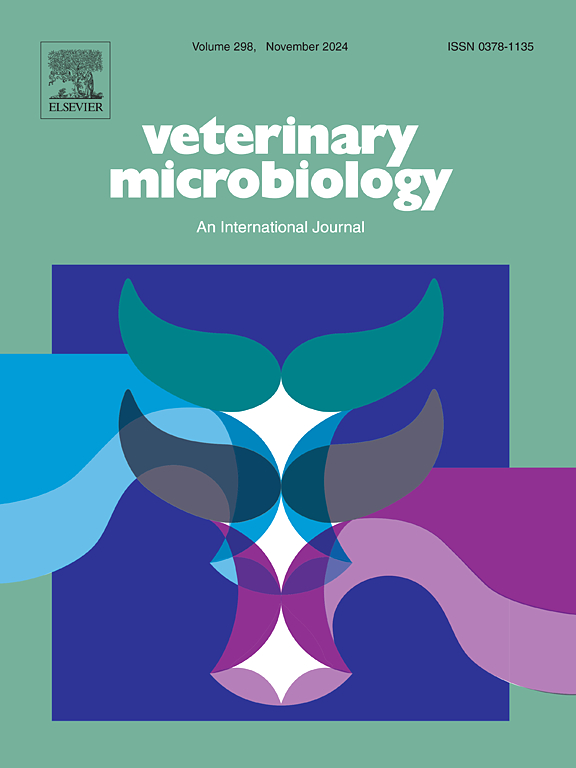Sequential emergence and quantitative dynamics of key bacterial species preceding digital dermatitis lesion onset in dairy cattle
IF 2.4
2区 农林科学
Q3 MICROBIOLOGY
引用次数: 0
Abstract
Digital dermatitis (DD) is a skin infection of cattle’s feet with multiple bacteria suspected to be involved, yet its precise etiopathogenesis remains unclear. This longitudinal study explored the temporal changes of seven DD-associated bacteria in feet developing lesions or remaining healthy, while simultaneously investigating their persistence in potential reservoirs as sources of infection. Weekly swabs were collected from feet skin and saliva of 53 Holstein cows without DD lesions sequentially enrolled at calving in a commercial dairy herd. At the end of the study, samples from all cases and a subset of matched controls were analyzed (1:2 ratio) at five-time points (weeks −3, −2, −1, 0 - when early signs of DD were observed - and +1) and subjected to qPCR targeting Treponema phagedenis, T. medium, T. pedis, Porphyromonas levii, Bacteroides pyogenes, Fusobacterium necrophorum, and F. mortiferum. Linear mixed-effect models assessed the bacterial number changes within cows (cases) and between cows (cases vs controls). Throughout the study, 8 cows developed signs of DD. P. levii, F. necrophorum, and B. pyogenes numbers increased two weeks before the first visible lesion. T. phagedenis and T. pedis numbers increased one week before, suggesting a sequential colonization and potential synergism in triggering DD. Only P. levii and F. necrophorum were persistently present in saliva and skin, while Treponema spp. persisted solely in lesions. Our results inform specific bacterial dynamics associated with DD pathogenesis and might advise future attempts to effectively treat and control DD.
求助全文
约1分钟内获得全文
求助全文
来源期刊

Veterinary microbiology
农林科学-兽医学
CiteScore
5.90
自引率
6.10%
发文量
221
审稿时长
52 days
期刊介绍:
Veterinary Microbiology is concerned with microbial (bacterial, fungal, viral) diseases of domesticated vertebrate animals (livestock, companion animals, fur-bearing animals, game, poultry, fish) that supply food, other useful products or companionship. In addition, Microbial diseases of wild animals living in captivity, or as members of the feral fauna will also be considered if the infections are of interest because of their interrelation with humans (zoonoses) and/or domestic animals. Studies of antimicrobial resistance are also included, provided that the results represent a substantial advance in knowledge. Authors are strongly encouraged to read - prior to submission - the Editorials (''Scope or cope'' and ''Scope or cope II'') published previously in the journal. The Editors reserve the right to suggest submission to another journal for those papers which they feel would be more appropriate for consideration by that journal.
Original research papers of high quality and novelty on aspects of control, host response, molecular biology, pathogenesis, prevention, and treatment of microbial diseases of animals are published. Papers dealing primarily with immunology, epidemiology, molecular biology and antiviral or microbial agents will only be considered if they demonstrate a clear impact on a disease. Papers focusing solely on diagnostic techniques (such as another PCR protocol or ELISA) will not be published - focus should be on a microorganism and not on a particular technique. Papers only reporting microbial sequences, transcriptomics data, or proteomics data will not be considered unless the results represent a substantial advance in knowledge.
Drug trial papers will be considered if they have general application or significance. Papers on the identification of microorganisms will also be considered, but detailed taxonomic studies do not fall within the scope of the journal. Case reports will not be published, unless they have general application or contain novel aspects. Papers of geographically limited interest, which repeat what had been established elsewhere will not be considered. The readership of the journal is global.
 求助内容:
求助内容: 应助结果提醒方式:
应助结果提醒方式:


